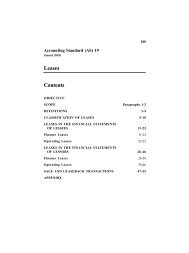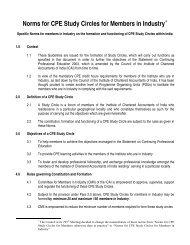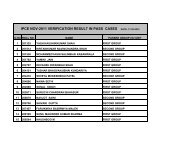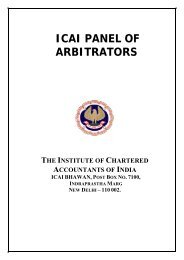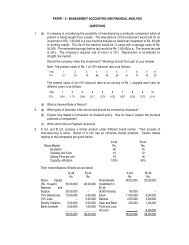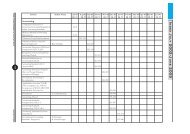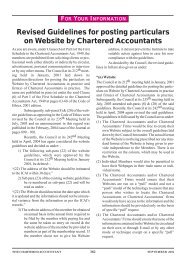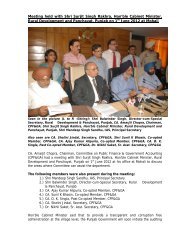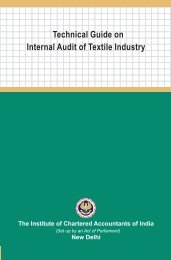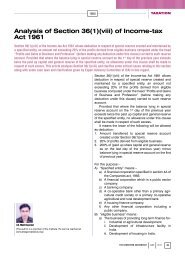Overview Solvency Margin in Indian Insurance Companies
Overview Solvency Margin in Indian Insurance Companies
Overview Solvency Margin in Indian Insurance Companies
Create successful ePaper yourself
Turn your PDF publications into a flip-book with our unique Google optimized e-Paper software.
THEME<br />
<strong>Overview</strong><br />
<strong>Solvency</strong> <strong>Marg<strong>in</strong></strong> <strong>in</strong> <strong>Indian</strong><br />
<strong>Insurance</strong> <strong>Companies</strong><br />
PRADEEP KANSAL<br />
And one may wonder<br />
as to whether the<br />
<strong>in</strong>surance premium<br />
paid by him is safely<br />
<strong>in</strong>vested and<br />
whether he would<br />
get back his sum<br />
assured at the end of<br />
the maturity period.<br />
Every <strong>in</strong>surance<br />
company is required<br />
to ma<strong>in</strong>ta<strong>in</strong> solvency<br />
marg<strong>in</strong>s based on its<br />
volume of bus<strong>in</strong>ess<br />
and as per the guidel<strong>in</strong>es<br />
stipulated by<br />
the IRDA. Hence,<br />
one need not bother<br />
as to the <strong>in</strong>vestment<br />
of his capital with<br />
any <strong>in</strong>surance company,<br />
<strong>in</strong> general.<br />
The solvency of an <strong>in</strong>surance<br />
company corresponds to its<br />
ability to pay claims. An<br />
<strong>in</strong>surer is <strong>in</strong>solvent if its assets are<br />
not adequate [over <strong>in</strong>debtedness] or<br />
cannot be disposed of <strong>in</strong> time {illiquidity}<br />
to pay the claims aris<strong>in</strong>g.<br />
The solvency of <strong>in</strong>surance company<br />
or its f<strong>in</strong>ancial strength<br />
depends chiefly on whether sufficient<br />
technical reserves have been<br />
set up for the obligations entered<br />
<strong>in</strong>to and whether the company has<br />
adequate capital as security.<br />
A case study could be used as an<br />
example of what happens when the<br />
<strong>in</strong>surance company fails to manage<br />
their asset liability composition —-<br />
“Nissan Mutual life was a<br />
Japanese Life <strong>Insurance</strong> Company<br />
with 1.2 million policyholders and<br />
assets of JPY 2 billions. Nissan<br />
Mutual Life sold <strong>in</strong>dividual annuities<br />
at guaranteed rates of 5 - 5 ½ %.<br />
The Japanese economy was then on<br />
high and the <strong>in</strong>terest rates wave<br />
high. And <strong>in</strong> early 90s the bubble<br />
burst. A whole host of outcomes followed<br />
the Government bond yields<br />
plunged to record low levels and a<br />
large gap was created between the<br />
company’s cost of liability and<br />
returns on assets. On April 25, 1997<br />
Japan’s F<strong>in</strong>ance M<strong>in</strong>istry ordered<br />
the company to suspend its busi-<br />
The author is with OM Kotak Mah<strong>in</strong>dra Life <strong>Insurance</strong>. He can be reached at<br />
pradeep_kansal05@rediffmail.com<br />
ness. Nissan Mutual was the first<br />
Japanese <strong>in</strong>surer to go bankrupt <strong>in</strong><br />
five decades. Its losses totaled<br />
JPY300 billions.”<br />
What is solvency marg<strong>in</strong>?<br />
<strong>Solvency</strong> marg<strong>in</strong> is the amount<br />
by which the assets of an <strong>in</strong>surer<br />
exceed its liabilities, and will form<br />
part of the <strong>in</strong>surer’s shareholder’s<br />
funds. Methods of valuations of<br />
assets and liabilities of an <strong>in</strong>surer<br />
are prescribed <strong>in</strong> the <strong>in</strong>surance regulations,<br />
Rules for estimat<strong>in</strong>g the<br />
liabilities will obviously be different<br />
for long-term and general <strong>in</strong>surance<br />
bus<strong>in</strong>ess. The regulations stipulated<br />
the m<strong>in</strong>imum solvency marg<strong>in</strong>,<br />
which an <strong>in</strong>surer must ma<strong>in</strong>ta<strong>in</strong><br />
THE CHARTERED ACCOUNTANT 1352 JUNE 2004
at all times. Separate solvency marg<strong>in</strong><br />
will be required for long-term<br />
and general <strong>in</strong>surance bus<strong>in</strong>ess of a<br />
composite company so that each<br />
bus<strong>in</strong>ess will stand on its own and<br />
not subsidise the other.<br />
For life <strong>in</strong>surance bus<strong>in</strong>ess, the<br />
m<strong>in</strong>imum solvency will normally be<br />
related to the policy reserve as disclosed<br />
by an actuarial valuation of the<br />
liabilities. For general <strong>in</strong>surance bus<strong>in</strong>ess,<br />
it is related to the higher of a percentage<br />
of net premium or net claim.<br />
There will also be a certa<strong>in</strong> m<strong>in</strong>imum<br />
amount required to be ma<strong>in</strong>ta<strong>in</strong>ed<br />
under statute <strong>in</strong> the solvency formula<br />
for each of the l<strong>in</strong>es of bus<strong>in</strong>ess.<br />
The <strong>Solvency</strong> <strong>Marg<strong>in</strong></strong> also<br />
denotes the capital base, def<strong>in</strong>ed as<br />
the surplus of assets over liabilities.<br />
It is often called shareholders’<br />
funds [<strong>in</strong> the UK] or policyholders’<br />
surplus [<strong>in</strong> the USA].<br />
<strong>Solvency</strong> ratios<br />
A parameter called the “solvency<br />
ratios” means the ratio of the<br />
amount of Available <strong>Solvency</strong><br />
<strong>Marg<strong>in</strong></strong> to the amount of Required<br />
<strong>Solvency</strong> <strong>Marg<strong>in</strong></strong>.<br />
The numerator of the ratio<br />
denotes the items such as:-<br />
(a) capital/funds<br />
(b) various reserve that <strong>in</strong>clude<br />
price fluctuation reserves and<br />
catastrophe reserves<br />
(c) a portion of unrealized profits<br />
obta<strong>in</strong>ed from real estate and stocks.<br />
The above characteristics call on<br />
the <strong>in</strong>surers to follow certa<strong>in</strong> basic<br />
pr<strong>in</strong>ciples of asset management:-<br />
➢ Safety – As a m<strong>in</strong>imum fund<br />
value should not erode.<br />
➢ Profitability – <strong>in</strong>vestment<br />
returns must exceed cost of liabilities.<br />
There should also be a<br />
risk buffer for sudden change <strong>in</strong><br />
<strong>in</strong>vestment environments.<br />
THEME<br />
➢ Liquidity – prepar<strong>in</strong>g for payment<br />
of claims and surrenders.<br />
The denom<strong>in</strong>ator of the ratio<br />
refers to the risks like :<br />
⌦ Underwrit<strong>in</strong>g Risks :- Risk of<br />
miscalculat<strong>in</strong>g premiums and<br />
miscalculate technical provisions.<br />
⌦ Risks on the expected <strong>in</strong>terest<br />
rates :- It is considered to be an<br />
important factor contribut<strong>in</strong>g<br />
to the <strong>in</strong>solvency of an <strong>in</strong>surance<br />
company.<br />
⌦ Risks related to asset management<br />
:- Growth risk aris<strong>in</strong>g out<br />
of exercise growth not matched<br />
by sufficient resources or due<br />
to wrong selections or wrong<br />
pric<strong>in</strong>g of products.<br />
In order to ma<strong>in</strong>ta<strong>in</strong> healthy<br />
asset liability ratio, life <strong>in</strong>surers<br />
world-over follow one or more of<br />
the follow<strong>in</strong>g assets-liability management<br />
methods:<br />
Cash flow test<strong>in</strong>g : The actuary<br />
tests the cash flow of the <strong>in</strong>surance<br />
company under various <strong>in</strong>terest rate<br />
scenarios.<br />
Cash flow match<strong>in</strong>g – Also known<br />
as dedication. A block of liabilities<br />
with identified cash flow would be<br />
matched with a block of assets with<br />
identical cash flow.<br />
Immunization – Duration of the<br />
liability portfolio is estimated and<br />
matched with an asset portfolio of<br />
identical durations.<br />
<strong>Insurance</strong> Regulatory And<br />
Development Authority has prescribed<br />
methods of valuation of<br />
assets and Liabilities of Life <strong>in</strong>surance<br />
and General <strong>Insurance</strong> as:<br />
DETERMINATION OF<br />
SOLVENCY MARGINS<br />
(a) “Available <strong>Solvency</strong> <strong>Marg<strong>in</strong></strong>”<br />
means the excess of value of<br />
assets (furnished <strong>in</strong> IRDA-Form-<br />
AA) over the value of life <strong>in</strong>surance<br />
liabilities (furnished <strong>in</strong><br />
Form H as specified <strong>in</strong><br />
Regulation 4 of <strong>Insurance</strong><br />
Regulatory and Development<br />
Authority (Actuarial Report and<br />
Abstract) Regulations, 2000) and<br />
other liabilities of policyholders’<br />
fund and shareholders’ funds;<br />
(b) “<strong>Solvency</strong> Ratio” means the<br />
ratio of the amount of Available<br />
<strong>Solvency</strong> <strong>Marg<strong>in</strong></strong> to the amount<br />
of Required <strong>Solvency</strong> <strong>Marg<strong>in</strong></strong>.<br />
1. Determ<strong>in</strong>ation of <strong>Solvency</strong><br />
<strong>Marg<strong>in</strong></strong> – Every <strong>in</strong>surer shall determ<strong>in</strong>e<br />
the required solvency marg<strong>in</strong>,<br />
the available solvency marg<strong>in</strong>, and<br />
the solvency ratio <strong>in</strong> Form K as<br />
specified under <strong>Insurance</strong> Regulatory<br />
and Development Authority<br />
(Actuarial Report and Abstract),<br />
Regulations, 2000.<br />
The boom <strong>in</strong> the <strong>in</strong>surance<br />
sector has triggered<br />
a stiff competition and it<br />
is the right time to relook<br />
at the exist<strong>in</strong>g solvency<br />
norms of the <strong>in</strong>surance<br />
companies.<br />
The debate now is<br />
whether the <strong>Solvency</strong><br />
<strong>Marg<strong>in</strong></strong> Regulations need<br />
to be restructured both<br />
for the Life and General<br />
<strong>in</strong>surance sector.<br />
The Debate<br />
As per the Regulation issued by<br />
the <strong>Insurance</strong> Regulatory and<br />
Development Authority (IRDA) the<br />
General <strong>Insurance</strong> <strong>Companies</strong> can<br />
follow the norms of the Regulatory<br />
Authorities. Accord<strong>in</strong>g to the former<br />
CMD of New India Assurance and<br />
THE CHARTERED ACCOUNTANT 1353 JUNE 2004
United India <strong>Insurance</strong> Ltd. Sh. KN<br />
Bhatnagar “A <strong>Solvency</strong> <strong>Marg<strong>in</strong></strong> of<br />
about or less than 100% <strong>in</strong> India as it is<br />
considered to be quite dangerous, this<br />
requires very close monitor<strong>in</strong>g of the<br />
<strong>in</strong>surer by regulator along with str<strong>in</strong>gent<br />
actions like upper limit on payment<br />
of dividends, remunerations to<br />
directors, restrictions on the bus<strong>in</strong>ess<br />
operation etc. It is generally stated<br />
that the problems aris<strong>in</strong>g out of the<br />
position and strength of the General<br />
<strong>Insurance</strong> Company will not be aris<strong>in</strong>g<br />
if this ratio is either 200% or more.<br />
On the other hand, the Life<br />
<strong>Insurance</strong> <strong>Companies</strong> have been<br />
asked to ma<strong>in</strong>ta<strong>in</strong> a 150% <strong>Solvency</strong><br />
<strong>Marg<strong>in</strong></strong> which <strong>in</strong>cludes a 50% additional<br />
cushions over and above the<br />
norms specified <strong>in</strong> the regulations.<br />
A controversy has surfaced<br />
over LIC’s solvency, with the<br />
<strong>Insurance</strong> Regulatory and<br />
Development Authority question<strong>in</strong>g<br />
the lack of capital while the<br />
THEME<br />
The Life <strong>Insurance</strong> Sector also<br />
requires a quick review of the<br />
exist<strong>in</strong>g solvency norms. The<br />
norms are to be refurbished on<br />
the follow<strong>in</strong>g grounds:<br />
(a) The factors used <strong>in</strong> solvency<br />
calculations have to capture<br />
the-risks <strong>in</strong> the products<br />
more clearly.<br />
(b) The statutory reserv<strong>in</strong>g the solvency<br />
requirements have to be<br />
viewed <strong>in</strong> an <strong>in</strong>tegrated way.<br />
(c) The factors should give credit<br />
to a company’s size and risk<br />
management policies.<br />
(d) Clear regulatory marg<strong>in</strong><br />
should be established <strong>in</strong> solvency<br />
for risks that are of<br />
non-quantifiable nature <strong>in</strong><br />
the bus<strong>in</strong>ess.<br />
organization is push<strong>in</strong>g the issue of<br />
Government guarantees. All LIC<br />
policies have a sovereign guarantee.<br />
Invitation for Expression of Interest<br />
Anand Rao Vithoba Adsul, exunion<br />
M<strong>in</strong>ister of State for F<strong>in</strong>ance<br />
(Bank<strong>in</strong>g, <strong>Insurance</strong> and Expenditure)<br />
says: “The guarantee is on<br />
paper. Every day there are transactions<br />
with the public guarantees will<br />
not help because this is the condition<br />
of all State Government entities”.<br />
(June’15 Economics Times)<br />
Accord<strong>in</strong>g to reports, LIC<br />
needs an additional capital <strong>in</strong>fusion<br />
of up to Rs.20,000 crores to<br />
ma<strong>in</strong>ta<strong>in</strong> the solvency criterion<br />
stipulated by the IRDA. (Sept ‘1<br />
Economics Times)<br />
The Life <strong>Insurance</strong> Corporation<br />
of India has sought a five<br />
years time frame to meet the additional<br />
50 percent <strong>Solvency</strong> <strong>Marg<strong>in</strong></strong><br />
as asked by the IRDA. In keep<strong>in</strong>g<br />
with the IRDA Act, LIC will meet<br />
the 100 percent fiscal year 2004,<br />
said the Corporation’s Chairman<br />
Sh. S.B. Mathur. (Sept ‘1<br />
Economics Times) ■<br />
For prepar<strong>in</strong>g Background Materials for Cont<strong>in</strong>u<strong>in</strong>g Professional Education Programmes<br />
of the Institute.<br />
The Cont<strong>in</strong>u<strong>in</strong>g Professional Education Programmes are be<strong>in</strong>g conducted throughout India by the CPE<br />
Programme Organis<strong>in</strong>g Units.CPE Directorate is entrusted with the responsibility of, <strong>in</strong>ter alia, to create,<br />
assist <strong>in</strong> the development of, adm<strong>in</strong>ister and monitor such mechanisms as may be required for the purposes<br />
of Cont<strong>in</strong>u<strong>in</strong>g Professional Education for members <strong>in</strong> terms of the Statement on Cont<strong>in</strong>u<strong>in</strong>g Professional<br />
Education and as may be entrusted to it by the CPE Committee from time to time. One of the major responsibilities<br />
of CPE Directorate <strong>in</strong> the CPE endeavour is to br<strong>in</strong>g out Background Materials for various topics<br />
identified by the CPE Committee for conduct<strong>in</strong>g CPE Programmes by the POUs.<br />
The CPE Committee <strong>in</strong>vites Expression of Interest from members of the Institute and other experts who are<br />
<strong>in</strong>terested <strong>in</strong> develop<strong>in</strong>g CPE Background Materials on the topics of professional <strong>in</strong>terest to the members<br />
of the Institute. The <strong>in</strong>tend<strong>in</strong>g authors of the CPE Background materials are expected to have appropriate<br />
level practical experience <strong>in</strong> the relevant area.<br />
For complete details <strong>in</strong> this regard, please see the website of the Institute at http://www.icai.org/announ/eoi-<br />
2004.pdf<br />
It may be noted that mere submission of the Expression of Interest may not lead to the allotment of the particular<br />
background materials to a particular applicant. The Institute reserves the right to request any other<br />
expert (though they might not have offered their expression of <strong>in</strong>terest <strong>in</strong> this regard) to prepare CPE<br />
Background materials. Only selected authors will be <strong>in</strong>dividually communicated.<br />
THE CHARTERED ACCOUNTANT 1354 JUNE 2004



